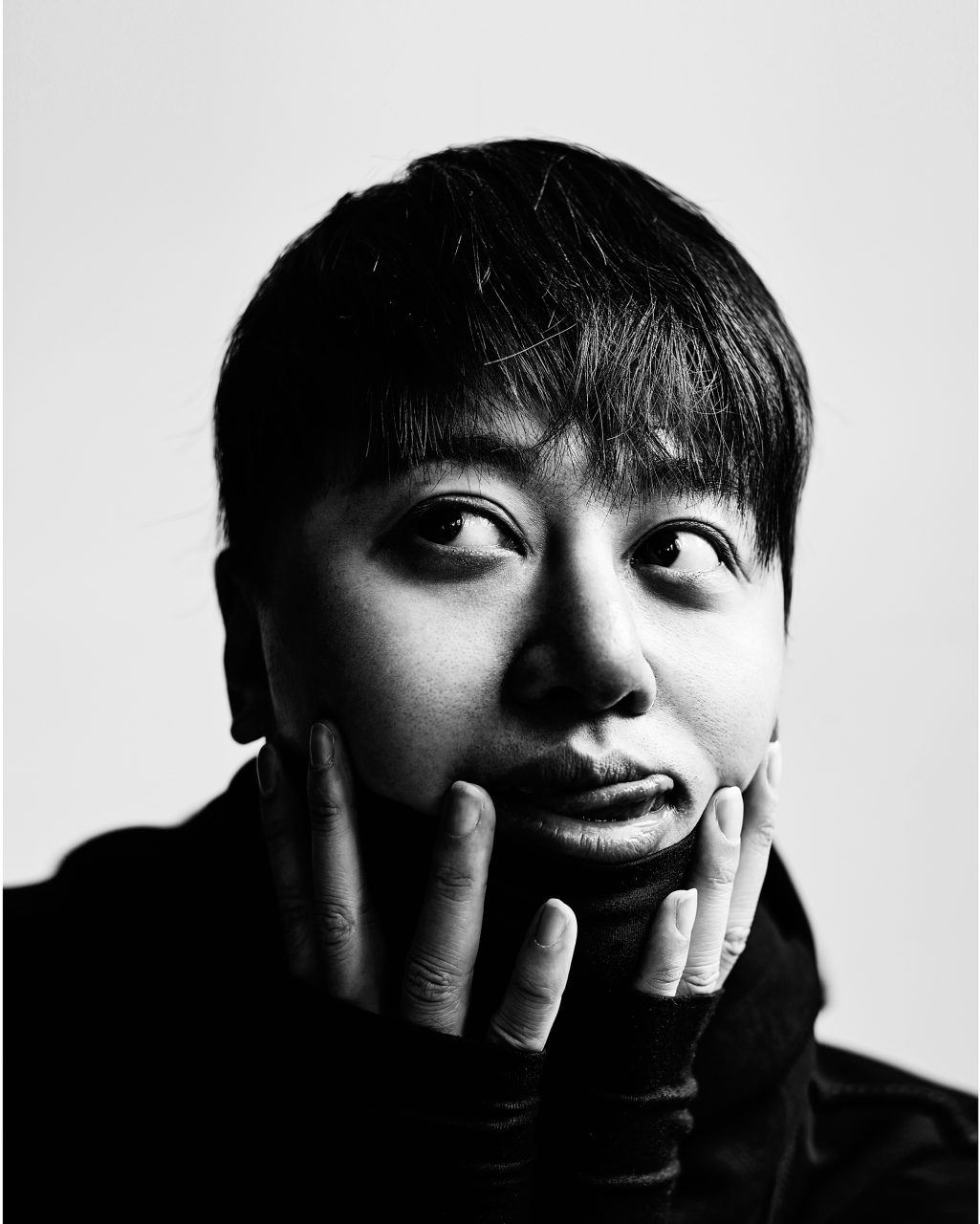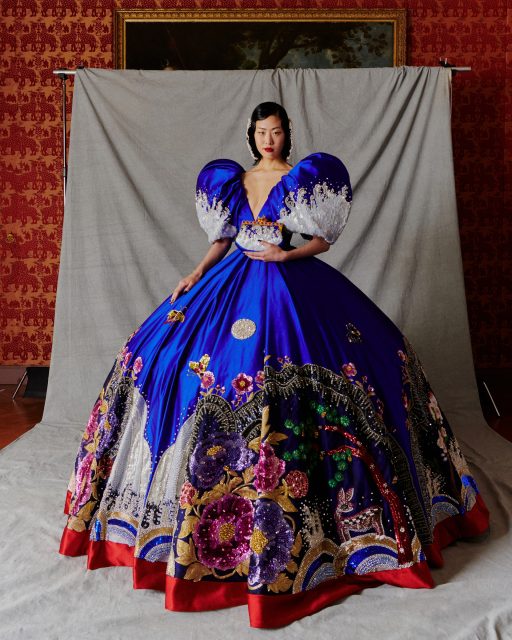While couture has long been associated with names such as Coco Chanel, Yves Saint Laurent and John Galliano, fresh Asian faces are paving a new path in the world of high dressmaking, changing the narrative in an industry dominated by luxury giants of the Western hemisphere.
Meet Celine Kwan, Yueqi Qi, Tomo Koizumi, Sohee Park, Ryunosuke Okazaki and Sensen Lii — six East Asian fashion designers making their mark. As part of K11 Musea and the Victoria and Albert Museum’s (V&A) joint exhibition “The Love Of Couture: Artisanship In Fashion Beyond Time”, these rising stars have designed bespoke couture pieces inspired by a collection of British and French womenswear garments from the 1830s to around 1960, specially curated by the V&A.
Masterminded by renowned Hong Kong production designer William Chang Suk Ping, “The Love of Couture” spotlights the original works of these six Asian designers alongside a chronological display of couture selections from the V&A archive. By presenting couture’s evolution across time and cultures, the exhibition invites guests to appreciate the historic, French-originating craft through a contemporary Asian lens.
Celine Kwan
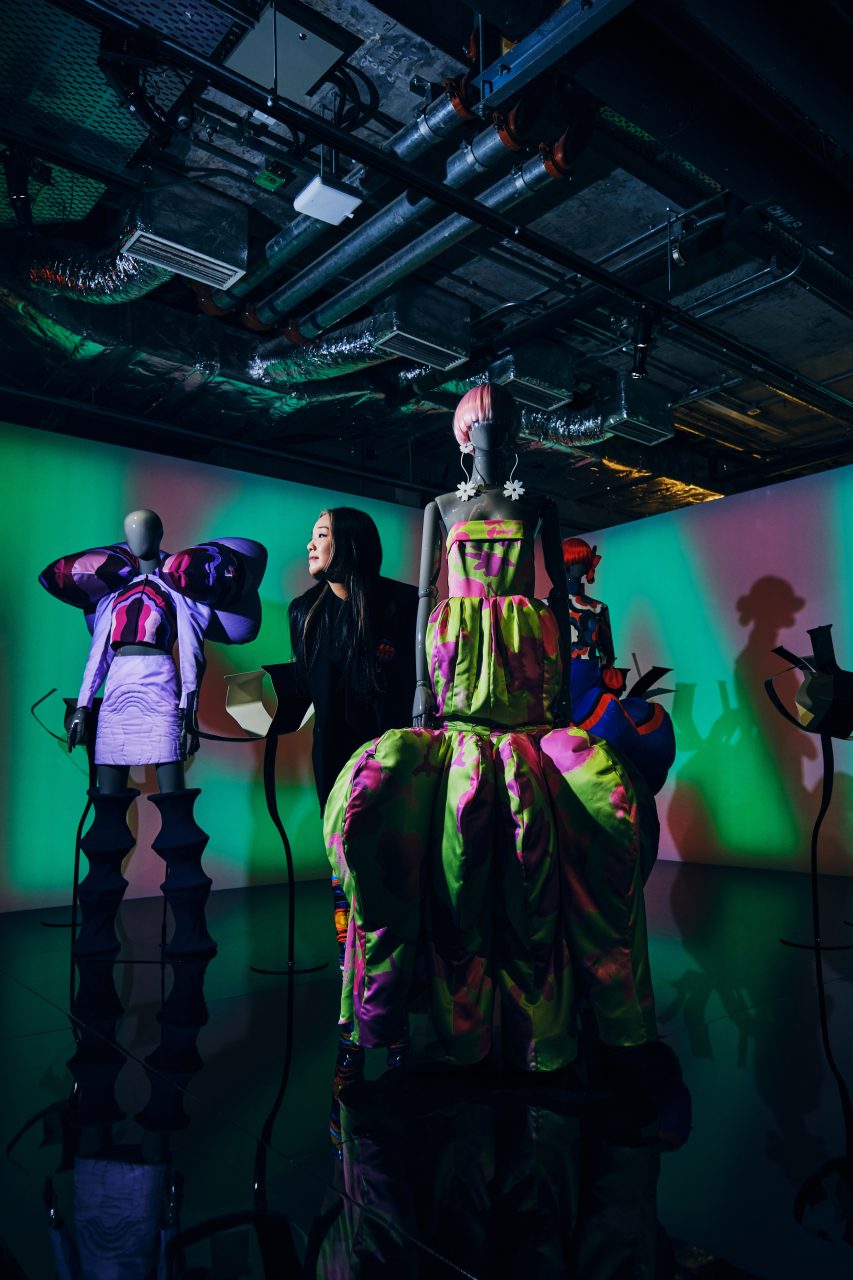
Celine Kwan poses with her new dress designed for “The Love of Couture: Artisanship In Fashion Beyond Time” exhibition
Photo: K11 Musea
Bringing her signature splash of vibrance to the space is Hong Kong’s very own Celine Kwan. Inspired by a yellow evening dress from post-war London, her gown is characterised by its whimsy lime and pink print and inflatable skirt.
The young designer crafts her billowing masterpieces with two objectives in mind. One, to turn heads and two, to make someone smile. “I am a very happy person so I really like to make people smile, especially with my clothes,” she laughs. “Fashion is too serious nowadays!”
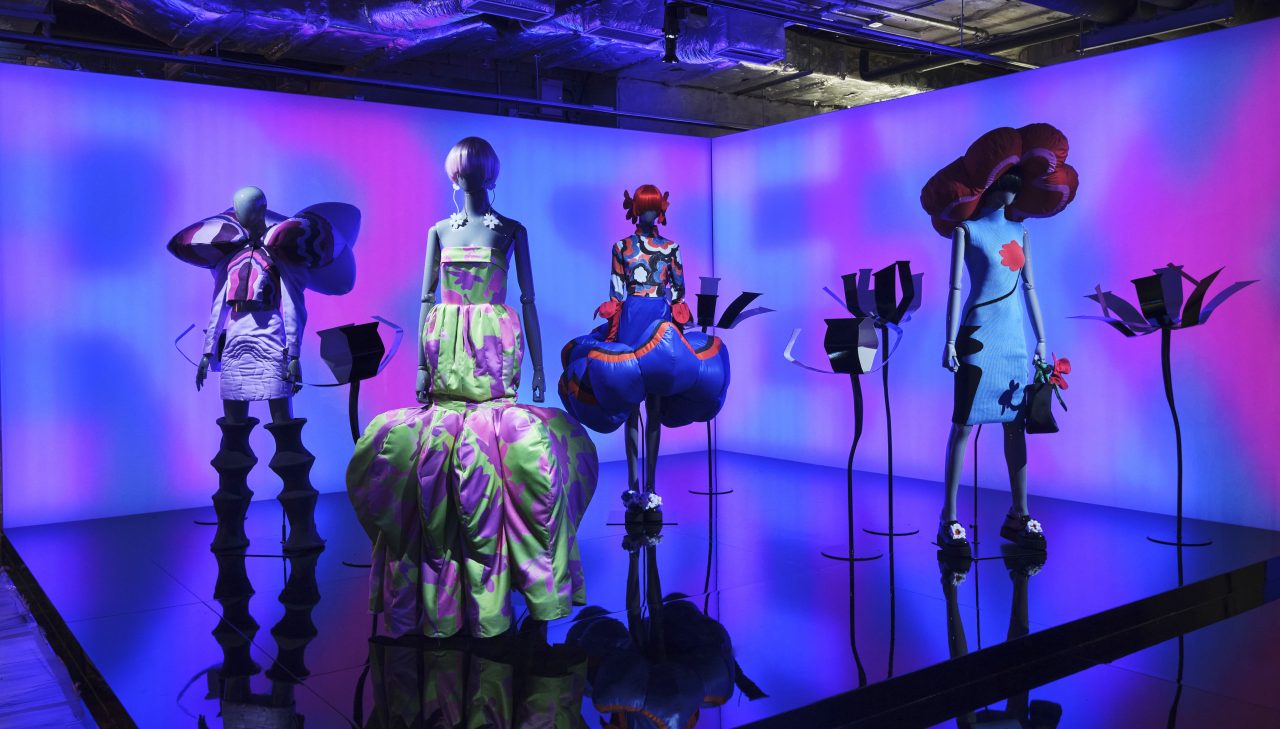
Works by Celine Kwan at “The Love of Couture: Artisanship In Fashion Beyond Time” exhibition
Photo: K11 Musea
Kwan is no stranger to standing out from the crowd. Born in Hong Kong, she left for the UK when she was twelve and was the only Asian student at her school. “It really taught me to break barriers and to be brave because I had to fend for myself,” she recalled. The tenacity she has as a designer, or her “oomph”, as Celine puts it, comes from her lived experiences as an Asian in the UK. “Oh, and I learnt not to give a damn about stereotypes,” she added with a grin.
“Since the bar has not been set for Asian designers in haute couture, there is so much potential and freedom for us to interpret the craft and bring our visions to life. We get to define or create our own definition of what couture can be as Asian designers, which is really exciting.”
Yueqi Qi
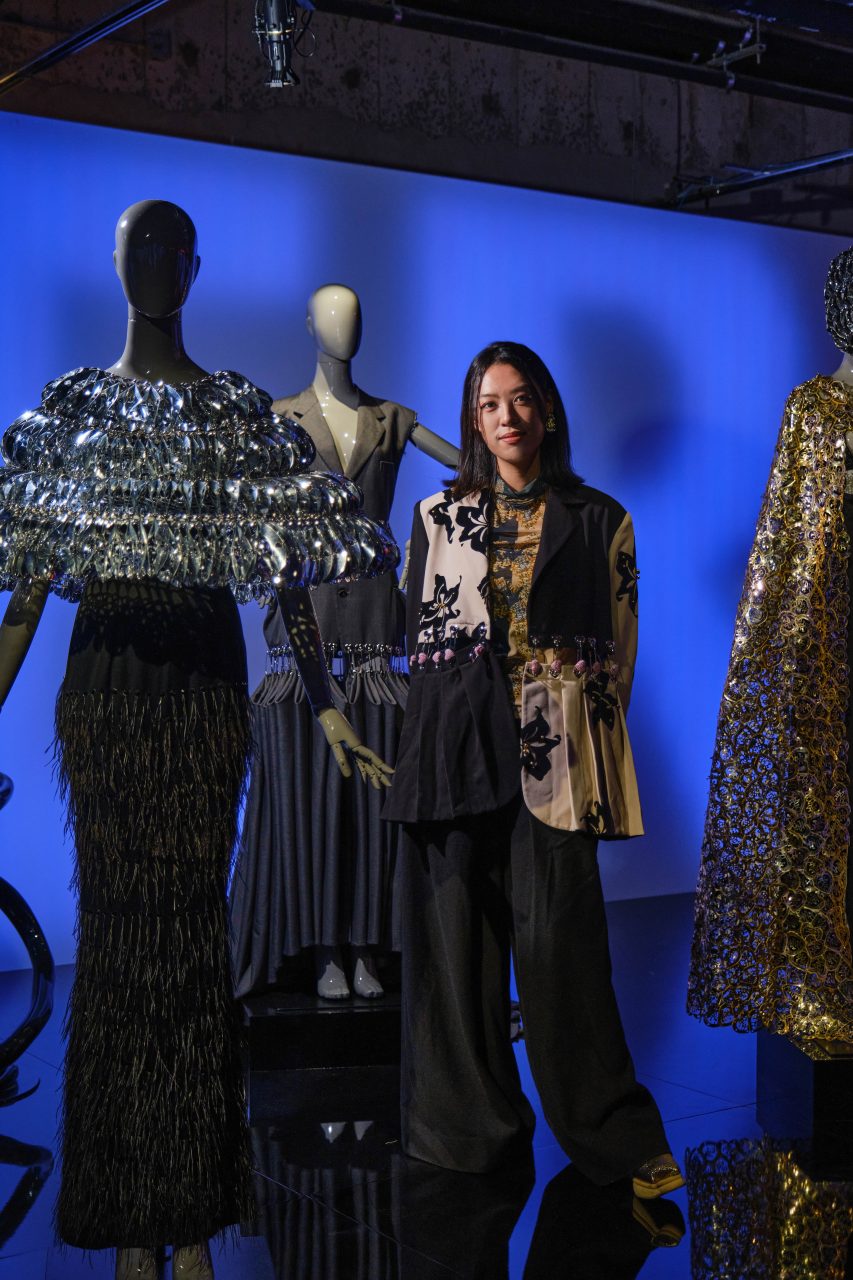
Yueqi Qi poses with her new designs at “The Love of Couture: Artisanship In Fashion Beyond Time” exhibition
Photo: K11 Musea
Love lies at the heart of Yueqi Qi’s creations. The Guangzhou-based designer centred her four-piece mini collection for the exhibition around a single motif: 「爱」, the Chinese character for love. Laser-cut metallic「爱」characters are linked into chains to form capes and dresses that toe the line between utilitarian and avant-garde. Behind her edgy, armour-like pieces, however, lies a story that will melt any heart.
“I established my brand when the pandemic first started. All the factories were shut, and I could not carry out production for my beaded garments. I was buying breakfast one day when I panicked out loud to an auntie working at the stall. ‘What should I do?’ I said, ‘There is no one who can help me with production.’ And she asked me, “What if you let me try?”
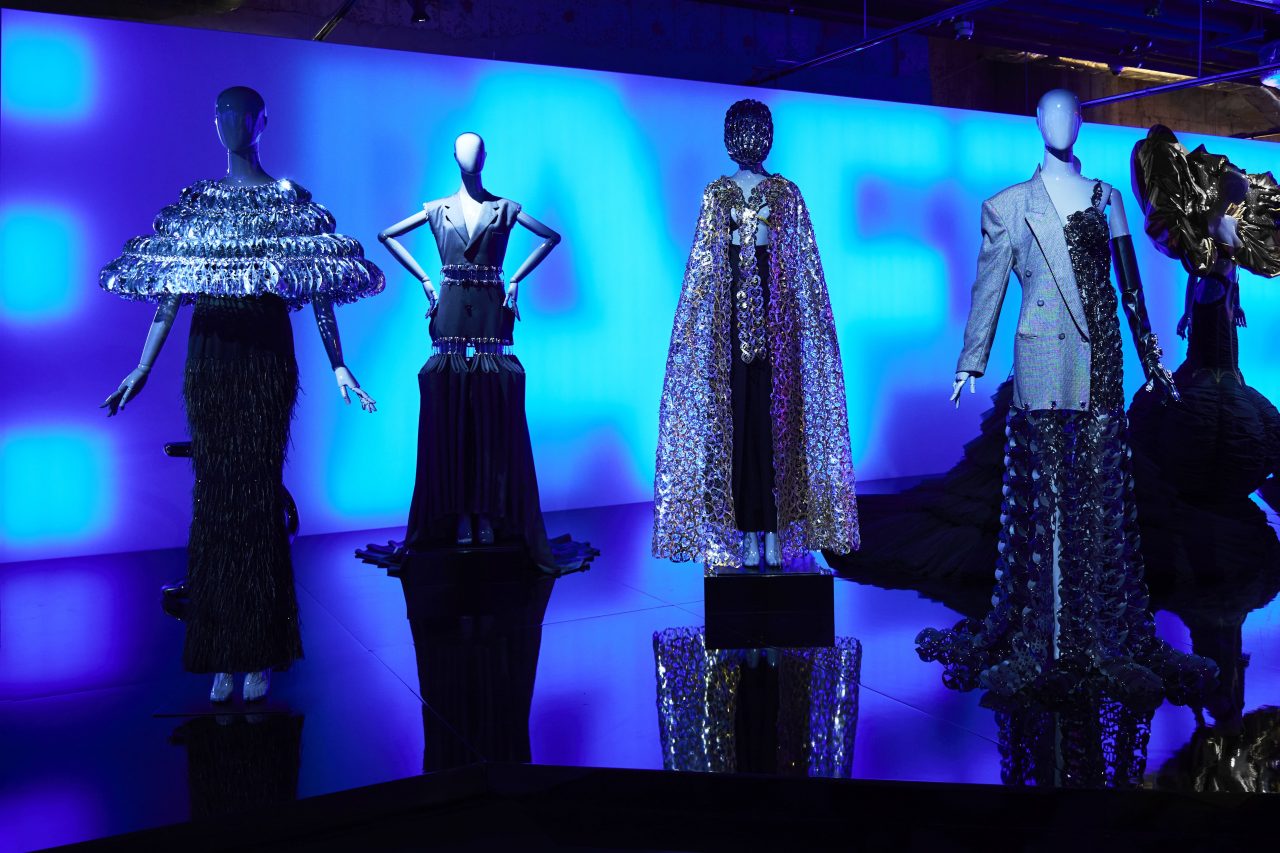
Works by Yueqi Qi at “The Love of Couture: Artisanship In Fashion Beyond Time” exhibition
Photo: K11 Musea
Today, Yueqi Qi’s eponymous brand is backed by an invincible team of over 300 women, from breakfast stall workers to housewives to disabled women with an eye for craft. “I have always been on the receiving end of love, and now I can give that love back. Through my beading supply chain, I hope to empower more housewives and disabled women with the opportunity to work from home. This is love,” she beamed with a radiant smile, “big love.”
To Qi, couture is a manifestation of another kind of love: a designer’s love for her craft. “Couture embodies a designer’s spirit. Ready-to-wear is often commercialised, but a designer speaks their heart and soul through couture,” she explained. “As long as you believe in yourself and stay true to what you stand for, your story will shine through your art, and it will be one-of-a-kind.”
Tomo Koizumi
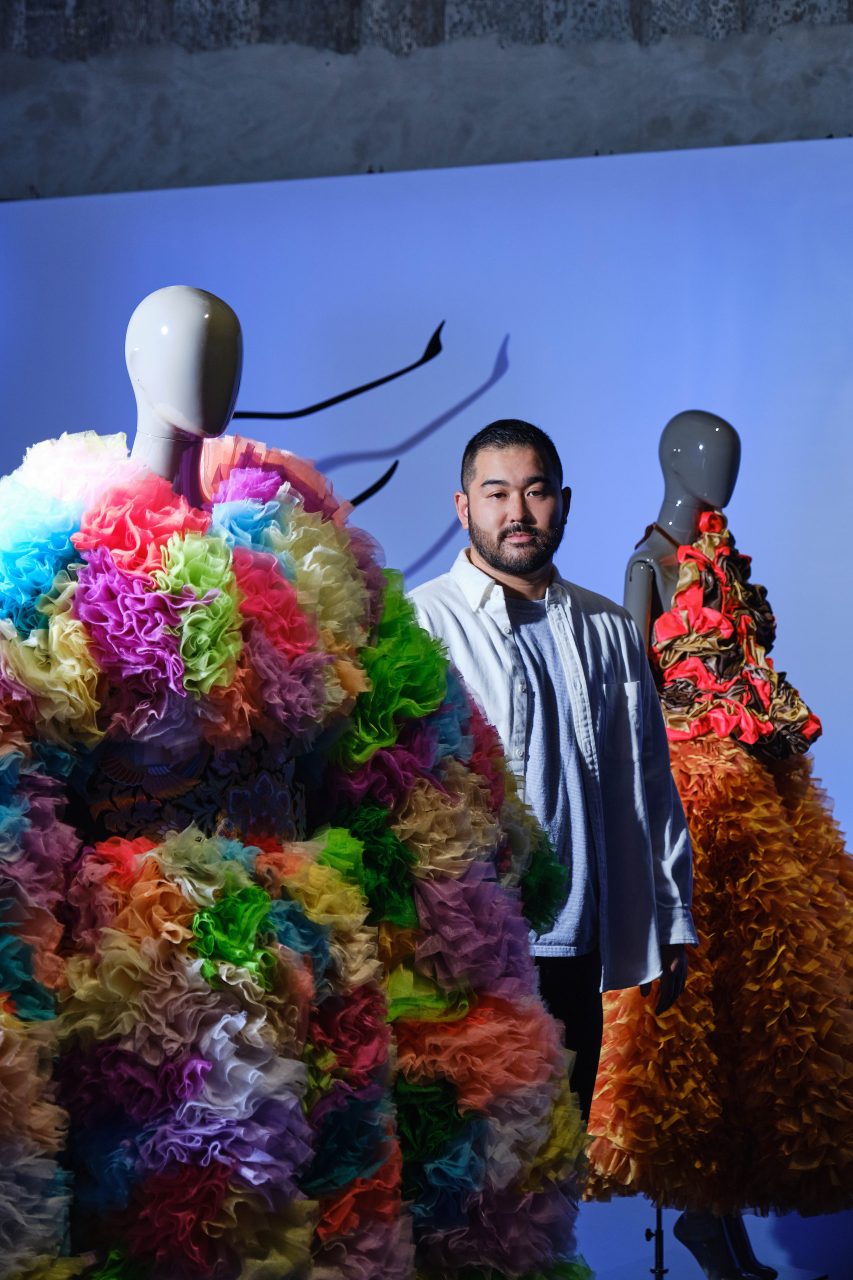
Tomo Koizumi poses with his designs at “The Love of Couture: Artisanship In Fashion Beyond Time” exhibition
Photo: K11 Musea
“Everyone can put ruffles on clothing, but not many people can actually make clothes from ruffles,” said Tomo Koizumi. And he belongs in the latter. The name of the Japanese designer has become synonymous with ruffles. Big and small, painted in every colour you can think of.
But why ruffles? “So, I grew up in this crazy, colourful garden…” he began to explain.
The crazy colourful garden in question? Florals and ribbons on funeral banners his mother prepared while working at his uncle’s funeral company. Having grown up surrounded by “huge plastic flowers that came in metallics and pastels”, Koizumi unknowingly transformed moments from his childhood into his signature ruffles, something he only realised in hindsight. “This goes to show how deeply it is embedded in my identity,” he said.
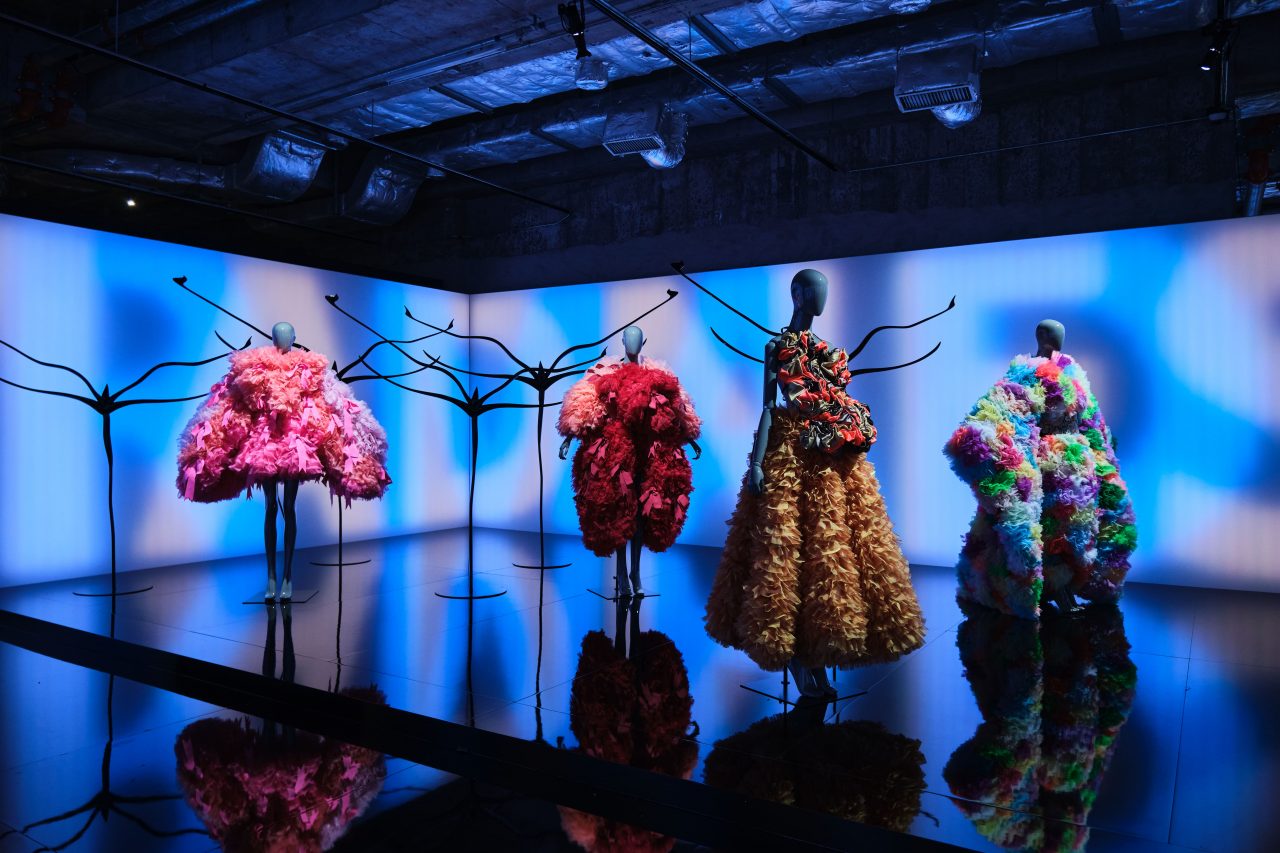
Works by Tomo Koizumi at “The Love of Couture: Artisanship In Fashion Beyond Time” exhibition
Photo: K11 Musea
His bespoke piece for the exhibition comprises a vest jacket and an A-line skirt meticulously handcrafted from ruffles in oranges, beiges and browns, a relatively muted palette that nods to the colourway of a wedding dress from 1830s England.
“The top is made from hand stitching and a smoking technique. I don’t usually use that much hand stitching, but this time, I wanted to bring out the handcraft and dedication that goes into couture.” He paused and chuckled as he made a tiny confession. “I actually didn’t do extensive research on the V&A dress I chose to reference. It just looked so cute, and I loved it!”
Cute is certainly one way you can describe the Tomo Koizumi brand. Influenced by Japanese pop culture, there is a light, bubbly sensibility to Tomo’s designs. “I grew up watching anime like Sailor Moon,” he shared, “In fact, the ideal Tomo Koizumi woman is like Sailor Moon! She might look cute in my dresses, but she is really strong.”
Ryunosuke Okazaki
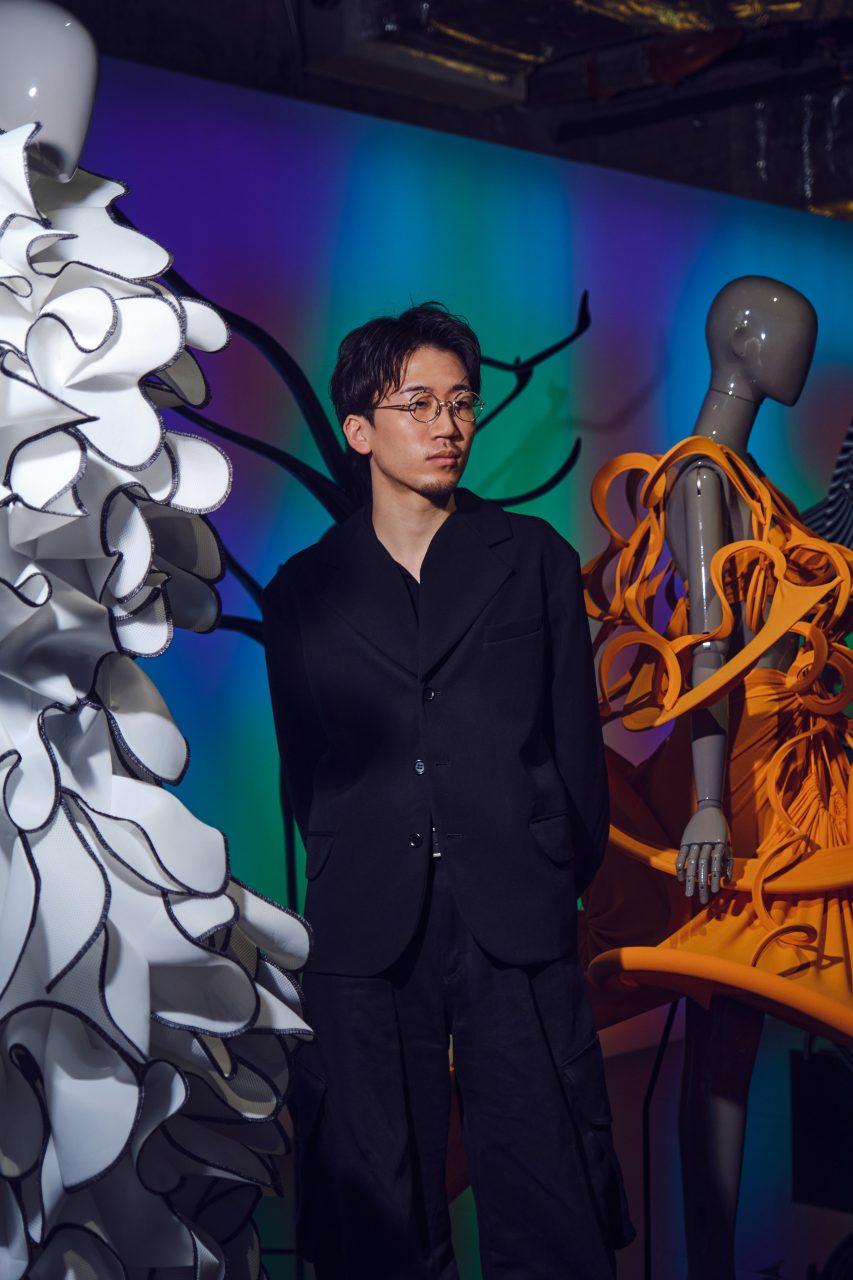
Ryunosuke Okazaki poses with his designs at “The Love of Couture: Artisanship In Fashion Beyond Time” exhibition
Photo: K11 Musea
Also hailing from Japan is Ryunosuke Okazaki, who has never drafted a sketch in the entirety of his fashion career. It can be hard to believe for anybody who has cast even the briefest of glances towards his avant-garde creations, but the designer finds it natural to work his magic with no blueprint.
“The elasticity, flexibility and weight of my materials determine how I work,” he explained. “I create everything using my bare hands. By interacting and forming a dialogue with the materials I am working with, unexpected forms can be created.”
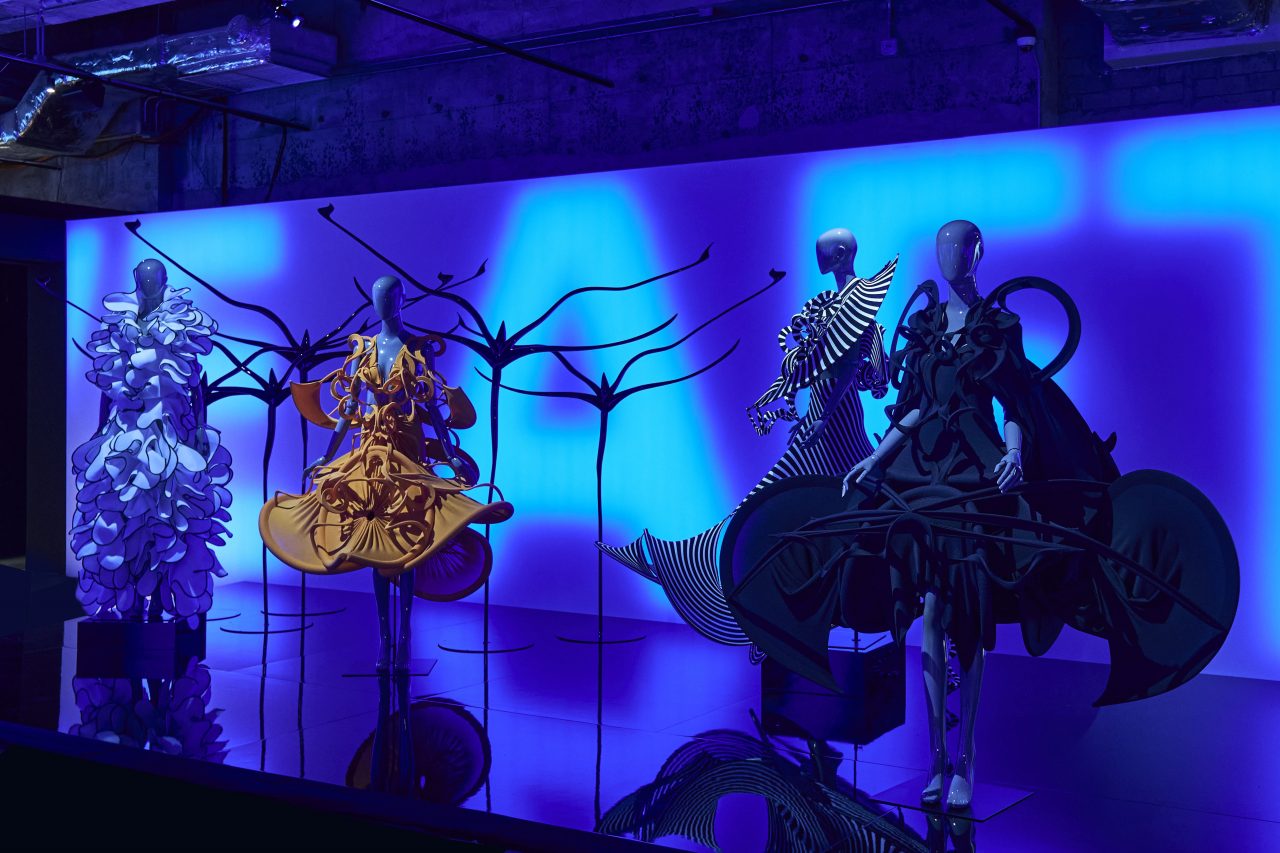
Works by Ryunosuke Okazaki at “The Love of Couture: Artisanship In Fashion Beyond Time” exhibition
Photo: K11 Musea
His garments are indeed unexpected. Okazaki’s newest creation transforms the 2D embroidery on Paul Poiret’s 1920s Samovar evening dress into 3D. He brings the golden threads to life through mesmerising sculptural curves that look otherworldly, but are also somewhat reminiscent of the geometric shapes you can find in nature.
Born and raised in Hiroshima, where the atomic bomb was dropped in 1945, the designer is captivated by the relationship between people, prayer and nature. “I am inspired by prayer, by Shinto and Jomon pottery,” he shared. “The Japanese Shinto religion makes us aware of the harmony between humanity and nature, and you can say it is a prayer for life. The spirit to survive, which lies at the heart of this prayer, is shared by generations of Japanese people.”
A “prayer” is how he describes his design process. “When people put on my clothes, I’d like to think that they putting on a piece of nature,” he continued, “and harmony is formed.”
Sohee Park
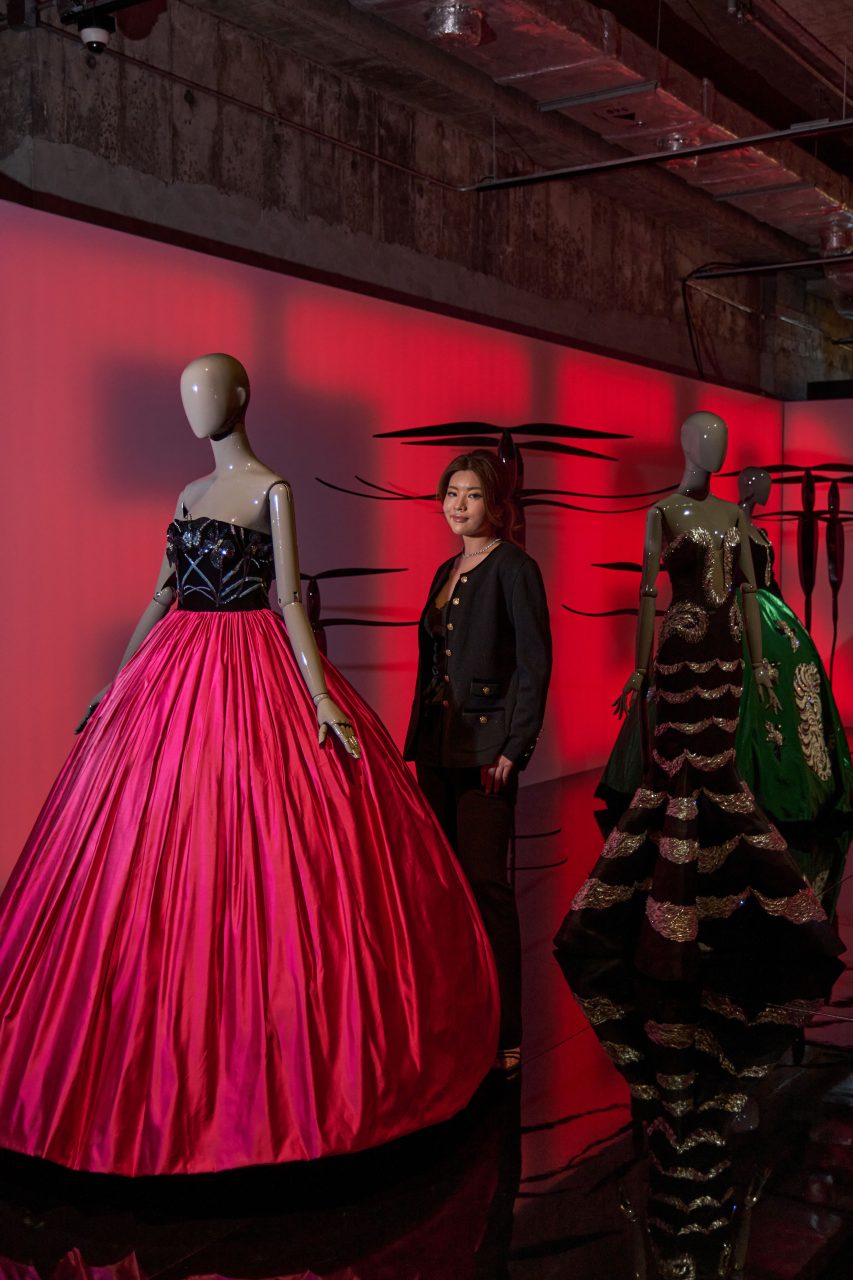
Sohee Park poses with her new dress designed for “The Love of Couture: Artisanship In Fashion Beyond Time” exhibition
Photo: K11 Musea
Fresh from her Milan Fashion Week debut with Dolce and Gabbana is Sohee Park, founder of Miss Sohee. Based in London, the South Korean couturier was also invited to create the V&A Museum’s Christmas tree this year, which she reimagined as a 3.5 metre-tall veiled statue dressed in a white silk chiffon cape embroidered with scintillating stars.
View this post on Instagram
Voluminous silhouettes and intricate embroidery are quintessentially Miss Sohee, and her new gown for the exhibition, inspired by Yves Saint Laurent’s Polynésie evening dress, is no exception.
“I need a big canvas to embroider on, so I really go for voluminous shapes and bring my sketches alive,” Park said with a twinkle of passion in her eyes. “I see myself continuing to do this. I don’t know how long, but very long.”
Sensen Lii
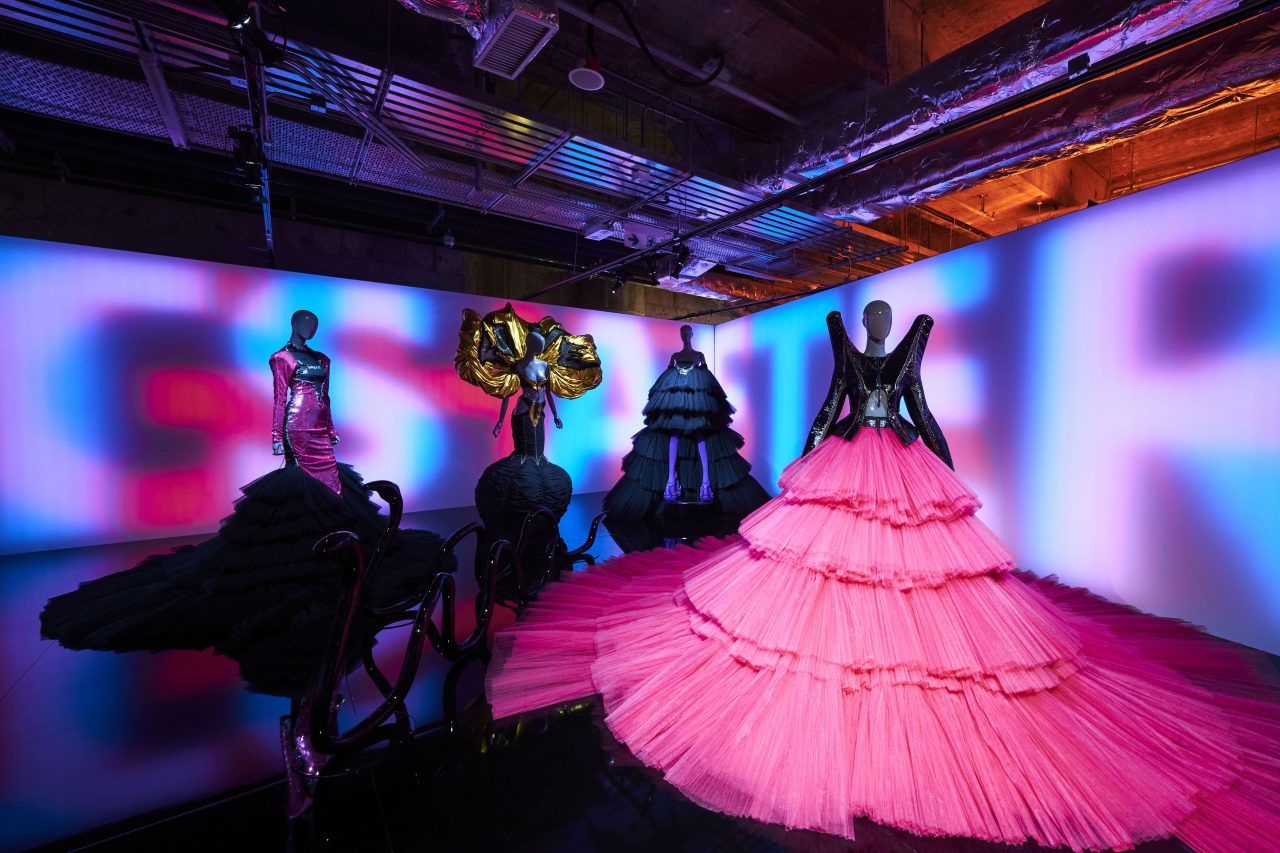
Works by Sensen Lii at “The Love of Couture: Artisanship In Fashion Beyond Time” exhibition
Photo: K11 Musea
Sensen Lii is not afraid to bring drama to the table. For “The Love of Couture”, the Chinese designer encapsulated the opulence of couture in three new pieces, each more sparkly and theatrical than the last.
“Historically speaking, couture is a very specific form of design. It must be custom-made for a specific person with a specific theme, concept and reason,” he stated. “But contemporary couture is more about pursuing feasibility and embraces more creativity and imagination.”
Chinese fashion designer Sensen Lii
Photo courtesy of K11 Musea
Imagination is at the core of his label WINDOWSEN. The name of his brand symbolises a literal window that connects our reality with Lii’s universe, which centres around his vision of an inclusive, post-human world. “To me, clothing is a tool that gives voice to different minority communities,” he shared.
And so, Lii speaks up through his clothes. Marrying the grandeur of haute couture with the technicality of sportswear, he continues to create bold genderless garments that fearlessly challenge the norms of our society.
Read Next
Sohee Park On Her Collaboration With Dolce & Gabbana And Taking Inspiration From Tradition
Editor
Kaitlyn LaiCredit
Lead Image: Courtesy of K11 Musea
